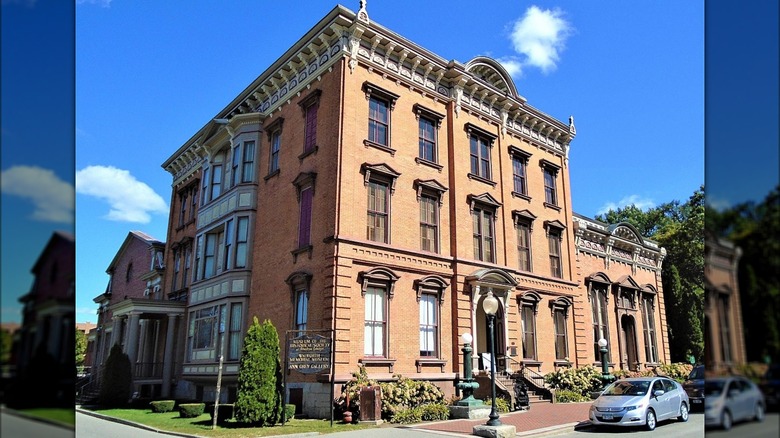The Club Sandwich Was Created In An Exclusive Club, But Nobody's Sure Which One
The classic club sandwich has been on the menus of diners for decades. Its charm still shows no sign of waning, and we doubt that it ever will. A single order is a tall stack of savory poultry of either chicken or turkey, ham, and bacon that's coated with rich mayonnaise. The meaty filling would be wedged together with fresh greens like lettuce and tomato between two slices of toasted bread (modern club sandwiches can be a triple-decker with an extra slice of bread in the middle.) No matter how hungry you are, you can count on a nice club sandwich to satisfy.
Over the years, the popularity of the sandwich has given rise to quite a few interesting bits of trivia and myths. For instance, many people believe that the name "club" is an acronym for "Chicken and Lettuce Under Bacon." The sleuths at Snopes have debunked this as false. Instead, the true story behind the club sandwich is a lot simpler: It was first made in the kitchen of an exclusive clubhouse as finger food for its members.
What's this "exclusive club," you ask? Well, people have floated the names of two famous clubhouses in New York in particular ... we're just not sure which one really came up with the club sandwich first.
The first candidate is the Union Club of New York City
The earliest mention of the club sandwich was on page two of the November 18, 1889 issue of The Evening World newspaper. The section starts by posing a curious question: "Have you tried a Union Club sandwich yet?" If you're a New Yorker, that name might be familiar to you. Yes, our first candidate is the so-called "Mother of Clubs": the Union Club of the City of New York.
According to a short biography-like section for a Mr. Ely Goddard published in The Vermont Tribune on October 6, 1893, Goddard was named the "inventor" of "sandwiches made of toasted bread and sliced chicken." Other newspapers, like the New York Herald in two separate issues in 1891 and 1893 also repeated this claim — that the world owed Goddard for his sliced chicken sandwich.
While he's the most often-repeated and likeliest person who came up with the sandwich, it's not exactly cut and clear. In the November 18th, 1889 issue of The Sun, the paper merely cited an unnamed "club chef" who had a hand in making and serving the sandwiches to club members. The wording of the article still leaves room for speculation. However, on the side of the Union Club, it seems like Goddard is its champion where the famous sandwich is concerned.
[Featured image by Wikis Take Manhattan by Headcases via Wikimedia Commons | Cropped and scaled | CC BY-SA 3.0]
The Saratoga Club House also threw in its hat
While the Union is a popular pick for "who created the club," the Saratoga Club House — now known as the Canfield Casino in Saratoga Springs, New York — has staked its own claim as the birthplace of the sandwich.
According to the club's website, the sandwich was either the brainchild of the club's owner, Richard Canfield, or the chefs working in the club's kitchen. Either way, their site reports that the Encyclopedia of American Food and Drink recorded the sandwich's appearance on the club's menu in 1894 — which was five years after The Evening World first mentioned the sandwich in 1889. Beyond this, there aren't many more pieces of evidence that solidify the Saratoga Club House's claim as the sandwich's creator.
Considering the wealth of documents and newspaper clippings recording the Union Club as the club sandwich's birthplace, it seems to have the strongest case out of the two. Whether it's true or not ... that's likely a question that'll never be definitively answered. Both Richard Canfield and Ely Goddard, as well as any 19th-century chefs who might have invented the sandwich, have long since passed away. Fortunately, the history of sandwiches like the peanut butter and jelly are far less controversial.
[Featured image by Beyond My Ken by Headcases via Wikimedia Commons | Cropped and scaled | CC BY-SA 4.0]


